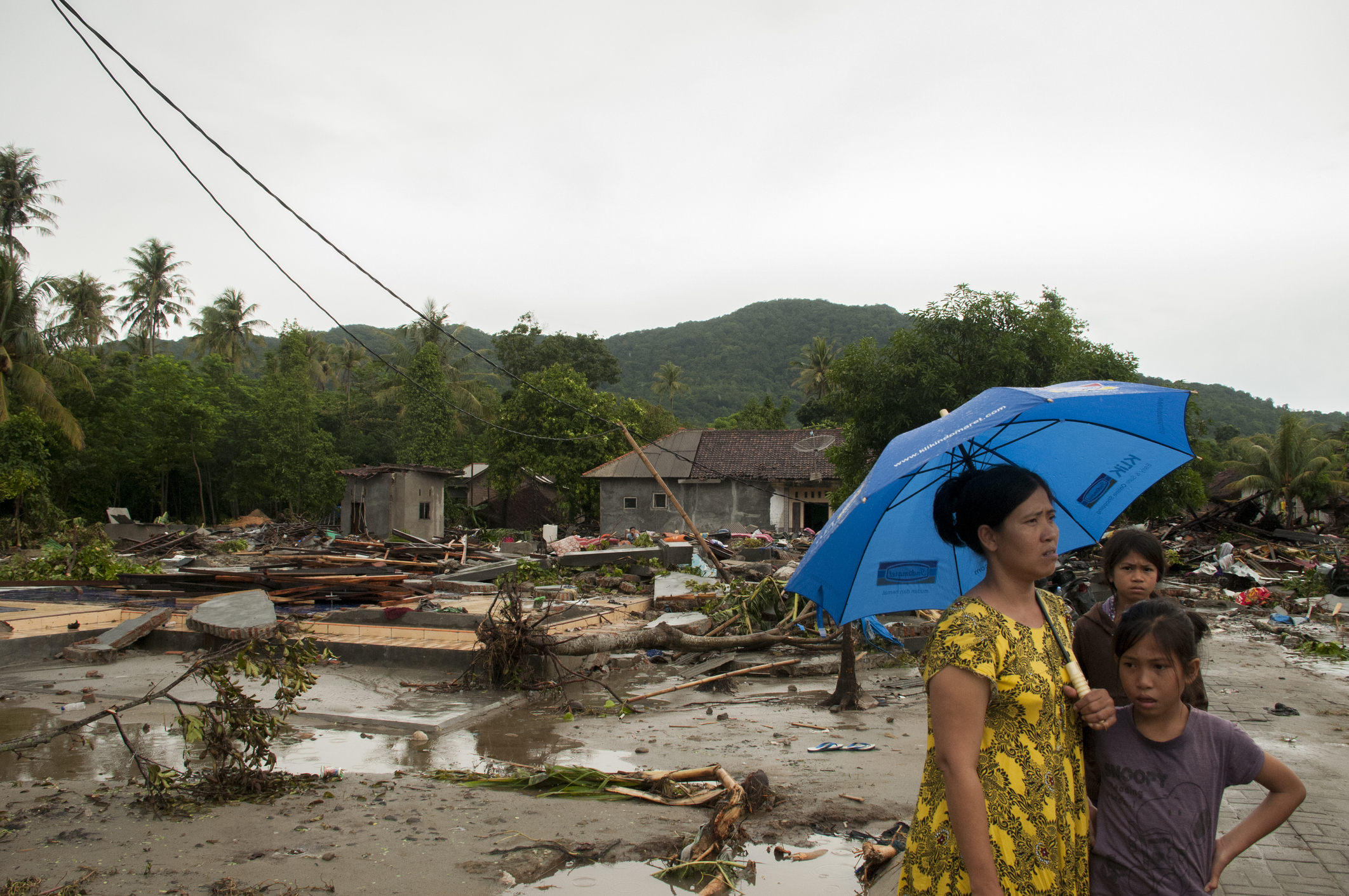
Belongings of tsunami victims left behind after being hit by a tsunami
on December 26, 2018 in the Banten province, Indonesia. Photo: ©Fajrul Islam
In 2004, the Indian Ocean Tsunami claimed over 230,000 lives and exposed critical vulnerabilities in countries across the Indian Ocean including Indonesia’s disaster response systems. This catastrophic event marked a turning point in Indonesia’s disaster risk management (DRM) approach. From adopting cutting-edge technologies to prioritizing social inclusion and resilient infrastructure, Indonesia’s path has been shaped by collaboration with global partners, including the World Bank’s Global Facility for Disaster Reduction and Recovery (GFDRR). Lessons from the Indian Ocean Tsunami’s experience inspired the creation of GFDRR in 2006, with a mission to integrate resilience into recovery efforts worldwide. Since then, GFDRR has supported Indonesia in developing innovative approaches and technologies to strengthen disaster preparedness.
The Beginning of an Integrated Approach to DRM
The 2004 tsunami prompted a comprehensive overhaul of Indonesia’s DRM framework, driving the need for innovative solutions around risk identification, assessment and planning. Through the Multi-Donor Fund (MDF) for Aceh and Nias—supported by the World Bank and other countries—the government mobilized $655 million to rebuild vital infrastructure that incorporated enhanced resilience standards. The results were tangible: over 20,000 homes reconstructed, 3,850 kilometers of roads restored, and 677 schools rebuilt, establishing new global benchmarks for post-disaster reconstruction.
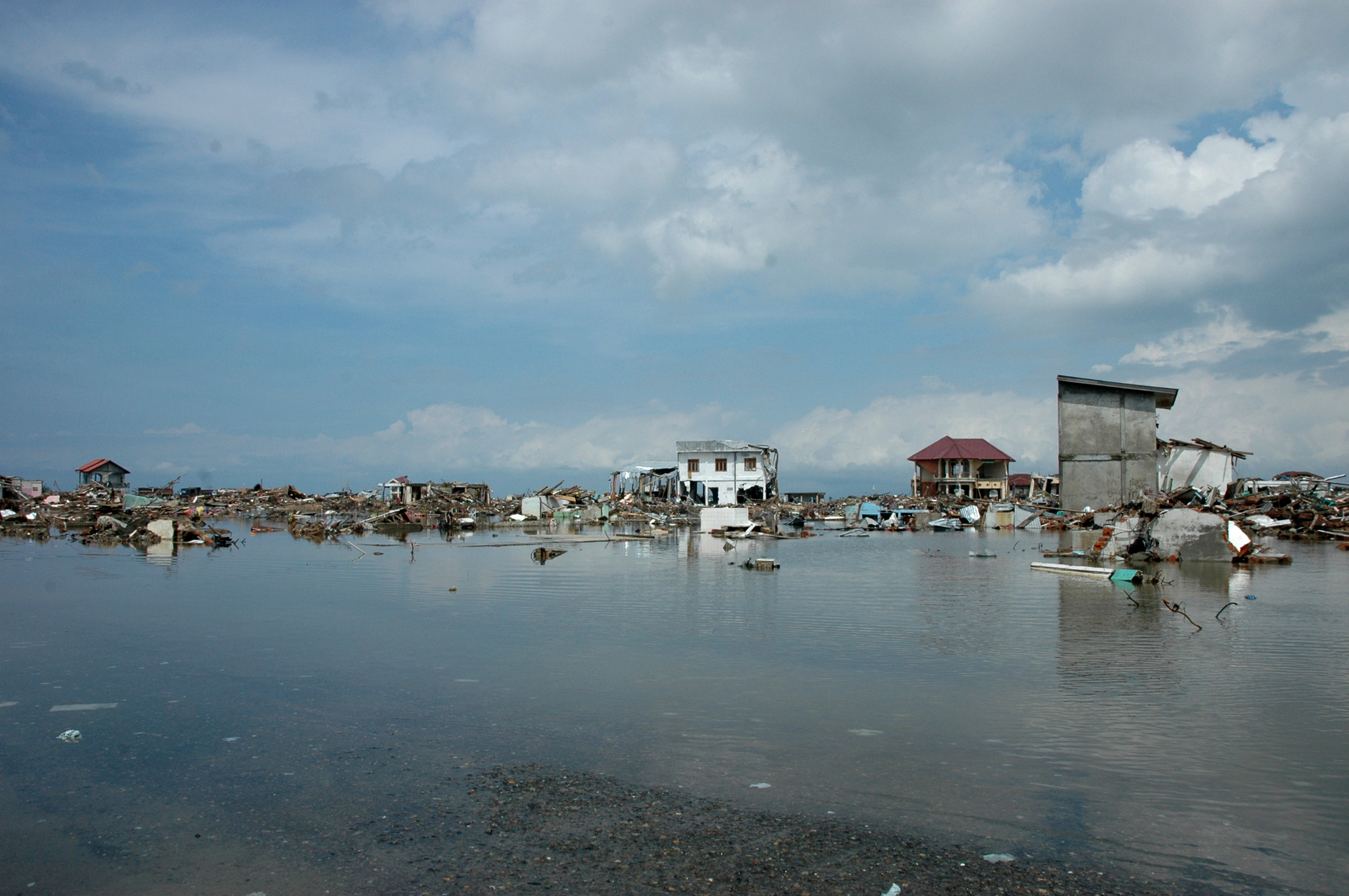
Banda Aceh City after the Indian Ocean earthquake and tsunami
of December 26, 2004. Photo: © Heri Mardinal
Another significant development post-tsunami has been the adoption of innovative risk identification tools to inform future decision-making and policy. For example, the Indonesia Scenario Assessment for Emergencies (InaSAFE)-- an open-source risk assessment platform developed with the support of the World Bank and the Australian government—has revolutionized local governments’ ability to simulate disaster scenarios and develop evidence-based contingency plans. By measuring the spatial impact of specific hazards on communities and infrastructure, InaSAFE has also helped communities better understand and assess the risks they face.
Building on this progress, initiatives like the Code for Resilience connected local technologies with DRM experts to create digital and hardware solutions that enhance resilience. These efforts yielded powerful mobile applications with digital mapping tools, empowering communities to make data-driven decisions during crisis.
Resilient Recovery
Indonesia has made important strides since then to strengthen its resilience to disasters. Following the volcanic eruptions of Mount Sinabung and Mount Merapi, the World Bank helped to establish the Indonesia Multi Donor Fund Facility for Disaster Recovery in 2009 to complement the government's DRM programs and rebuild local economies, retore individual livelihoods, and strengthen community resilience. Over 4,000 houses were constructed under this initiative.
The 2018 Central Sulawesi earthquake and tsunami tested Indonesia’s DRM systems under extreme conditions. The magnitude 7.5 earthquake triggered nearfield tsunamis, landslides, and soil liquefaction, causing over 4,400 fatalities, displacing 170,000 people, and inflicting $1.3 billion in economic losses. Demonstrating its commitment to proactive recovery, Indonesia worked with GFDRR to deploy a Global Rapid Post-Disaster Damage Estimation, which delivered damage assessments within 14 days. This assessment became the first comprehensive global report on the event’s impact, informing $438 million in World Bank assistance for recovery efforts.
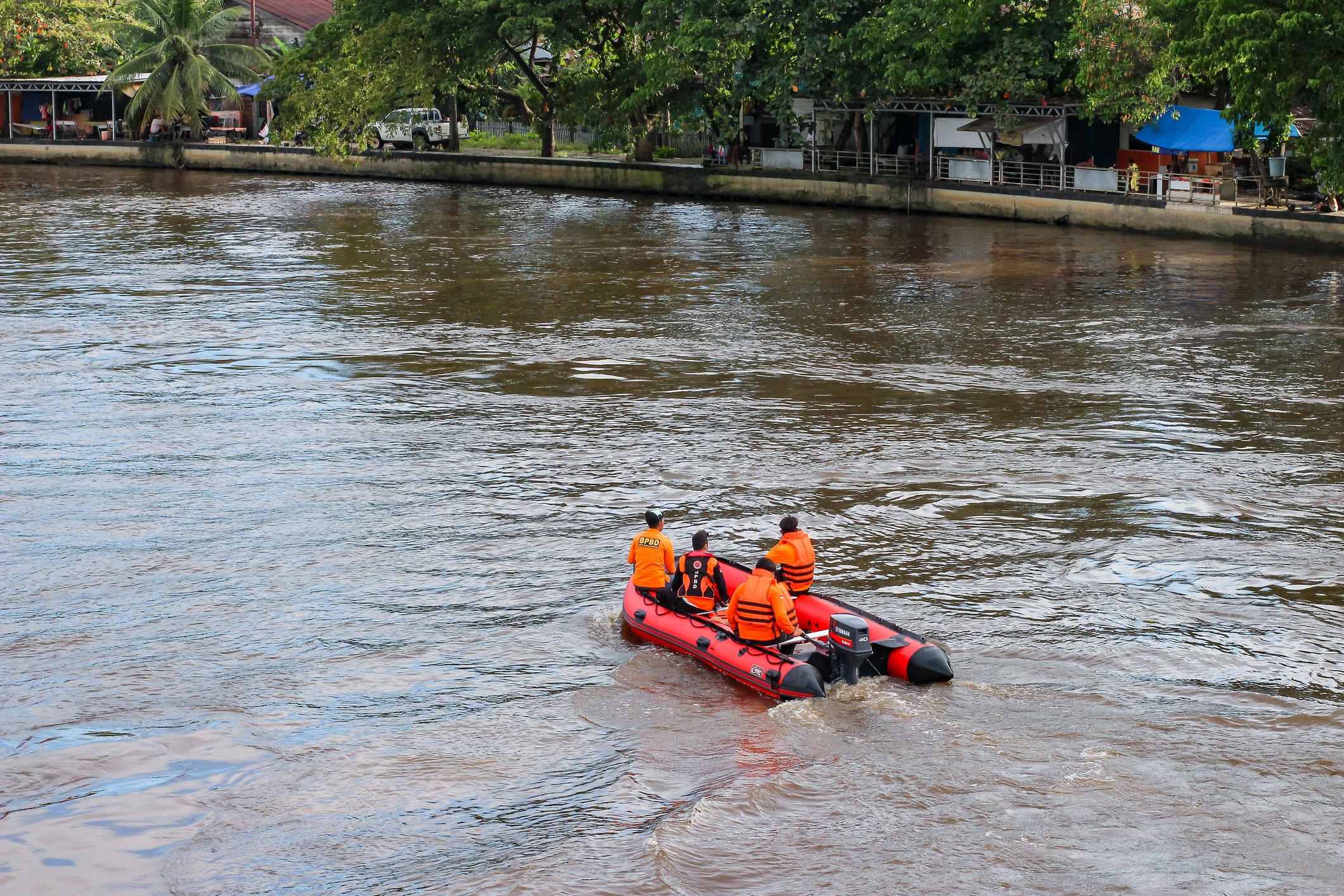
Indonesian flood rescue squad. Photo: © Adennysyahputra
To address urgent housing needs in Central Sulawesi and across the nation, the government of Indonesia, with support from GFDRR, introduced modular Rumah Instan Sederhana Sehat (RISHA) units. These homes, which can be constructed in under five days for less than $6,000 each, provided displaced families with safe, affordable shelter while showcasing scalable and resilient disaster recovery solutions.
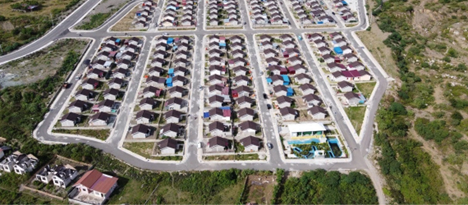
Source: Ministry of Public Works and Housing, Indonesia
Resilience, however, is not just about infrastructure—it's also about people, particularly those often overlooked in disaster resilience planning. The $150 million Central Sulawesi Rehabilitation and Reconstruction Project, financed by the World Bank, integrated universal access design principles, gender-based violence (GVB) mitigation, and collaboration with local women’s groups to ensure recovery efforts addressed the diverse needs of the community. For instance, housing designs were revised to include internal partitions after GFDRR-supported capacity building efforts on inclusive design standards.
“GFDRR technical assistance has improved our institutional and technical capacity in promoting inclusion and equality. Collaboration among stakeholders, including central and subnational governments, and local women’s representative groups and GBV service providers during the project lifecycle is key in delivering universal access design and taking GBV mitigation action. Social issues are core issues. Our Ministry championing GVB risk mitigation through this project is top priority.” —Astriana Astriana Harjanti, Ministry of Public Works and Housing of Indonesia
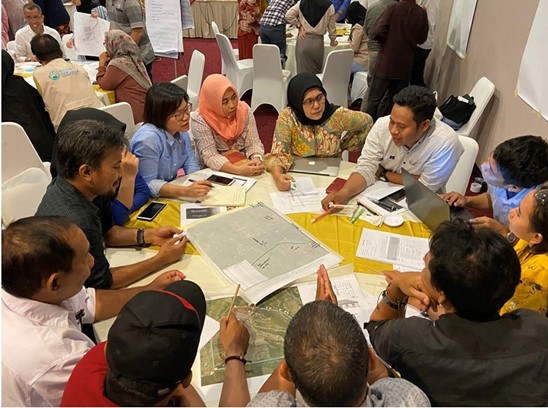
Participants sharing ideas on gender-inclusive design during a technical
workshop financed by GFDRR in December 2019. Photo: Jian Vun / World Bank
The $160 million Indonesia Disaster Resilience Initiatives Project, also financed by the World Bank, is enhancing geophysical early warning systems through modernized decision support systems, expanded instrumentation, and strengthened institutional capacity for more accurate and timely warnings.
Reducing Risk and Mainstreaming DRM
A $400 million National Urban Flood Resilience Project is helping to establish a national platform for investments in flood risk reduction across Indonesian cities at risk to flood hazards. The Bank-financed project is supporting integrated solutions in Banjarmasin, Bima, Manado, Medan and Semarang through structural and non-structural solutions, such as improved drainage capacities, integration of nature-based solutions, and better flood early warning systems. A key expected outcome is that poor and vulnerable people will be less exposed to flood hazards, which disproportionately affect these groups.
As Indonesia mainstreamed DRM across sectors, housing resilience became a priority. In addition to innovations like the RISHA housing units, GFDRR supported Indonesia’s $450 million National Affordable Housing Program which bolstered the resilience of Bantuan Stimulan Perumahan Swadaya, one of the largest home improvement programs globally. Through the technical assistance provided, the World Bank country team supported the government in raising the resilience standards from 11% in 2018 to 75% in 2023. Nearly one million households now live in safer, more resilient homes—a testament to the power of global expertise paired with local ambition.
In the water sector, GFDRR collaborated with local institutions to strengthen the capacity of utility operators. Training modules developed through this partnership are now integrated into national curricula, ensuring sustainable water systems management amid increasing urbanization and climate risks. Three local water utility providers have since adopted disaster resilience considerations into their operations.
Disaster Risk Finance & Preparedness and Response
To move beyond reactive disaster response, Indonesia established proactive disaster finance mechanisms like the Indonesia Disaster Fund, which facilitates quicker responses to national-scale disasters and streamlines coordination of international recovery assistance. Approximately 1% of the national budget is allocated to DRM, strengthening the country’s preparedness and response capabilities. GFDRR’s technical assistance supported the implementation of a national disaster risk financing and insurance strategy.
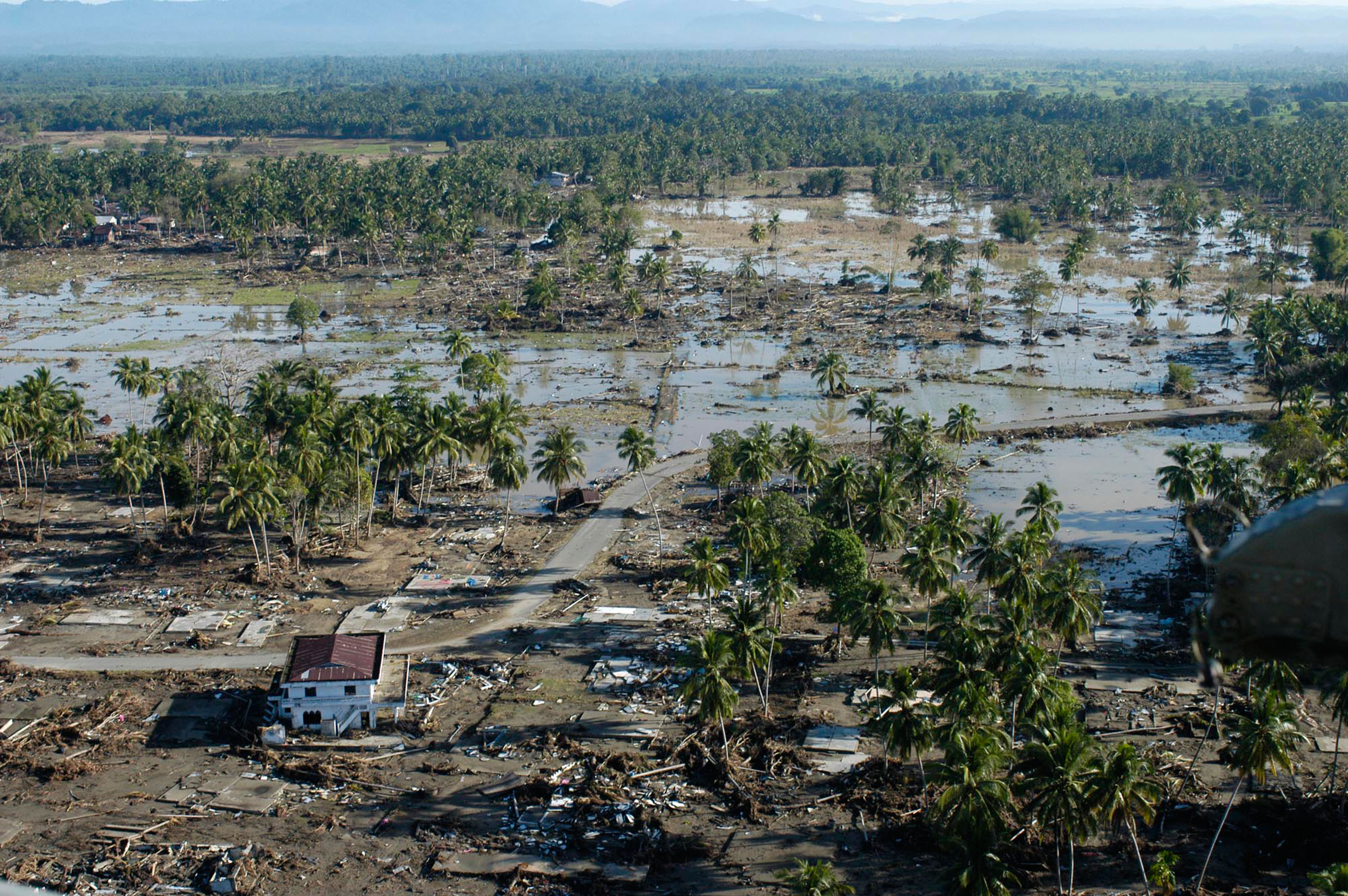
Aerial view of the tsunami damage in the village of Keude Teunom
in Aceh Indonesia. Photo: © Boitano Photography
To bolster anticipatory action, GFDRR Labs Challenge Fund, partnering with the Red Cross Red Cresence Climate Center and a tech start-up Kartoza, supported the development of an impact-based forecasting tool to address floods in Indonesia. This approach combines the understanding of forecasts, impact-hazard curves, and risk analysis to generate an intervention map that will inform when and where funds for early action should be deployed.
A Model for the Future
Indonesia’s DRM journey demonstrates the transformative power of sustained global collaboration in building resilience. With GFDRR’s support, Indonesia has embraced technology, inclusivity, and innovation to strengthen disaster preparedness and recovery—helping the nation not only build back better but build better before. This enduring partnership, marked by persistence and adaptability, has evolved beyond isolated initiatives into a replicable model for resilience-building, exemplifying what can be achieved when locally driven solutions meet global support in pursuit of a shared vision for a more resilient future.
Timeline: Select Highlights from GFDRR’s Partnership with Indonesia

